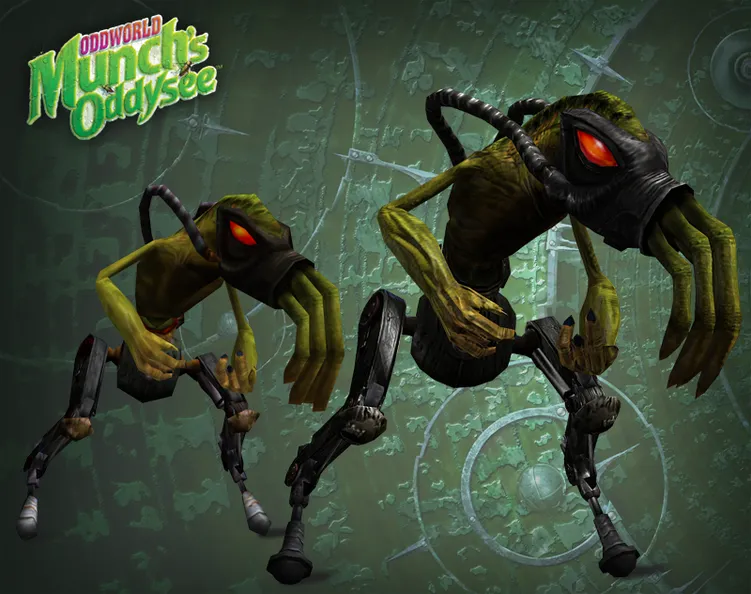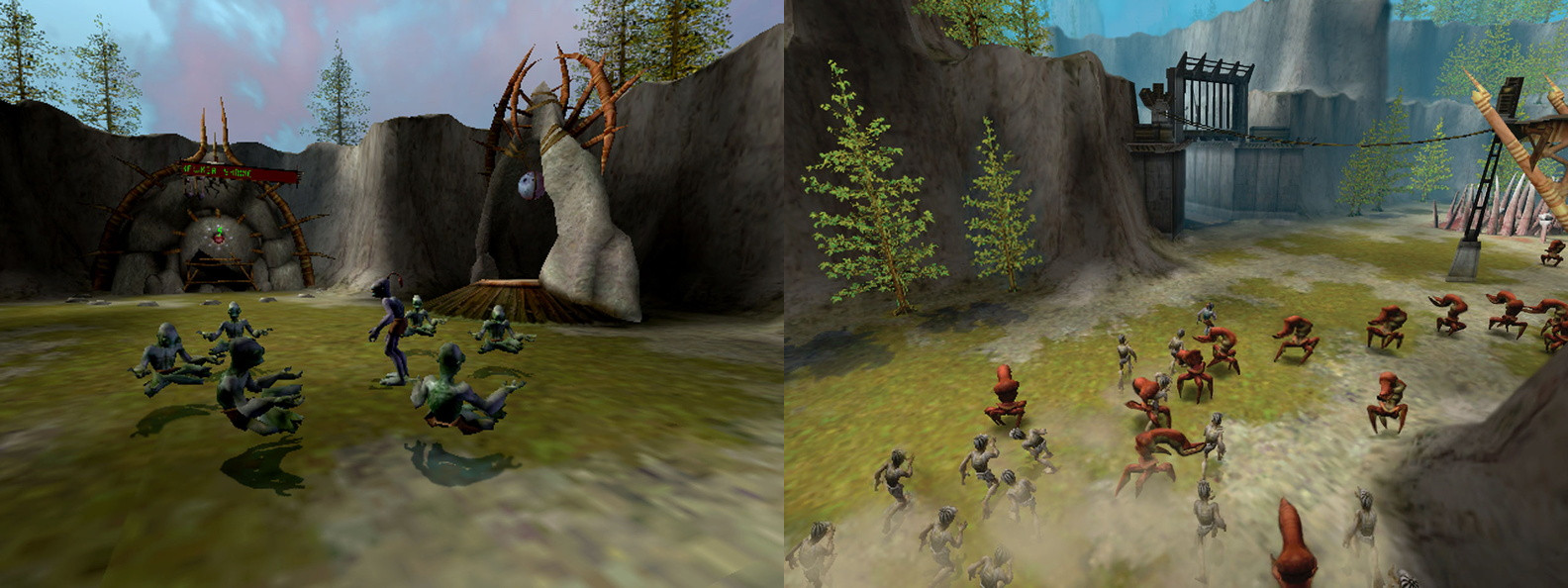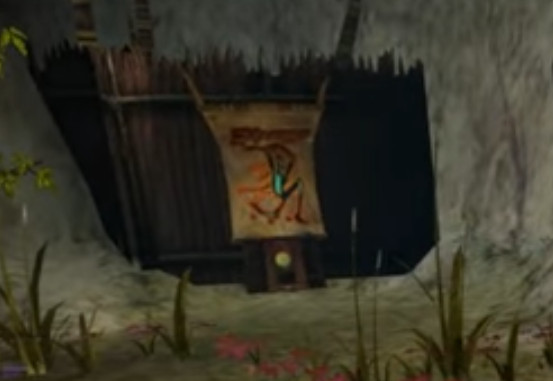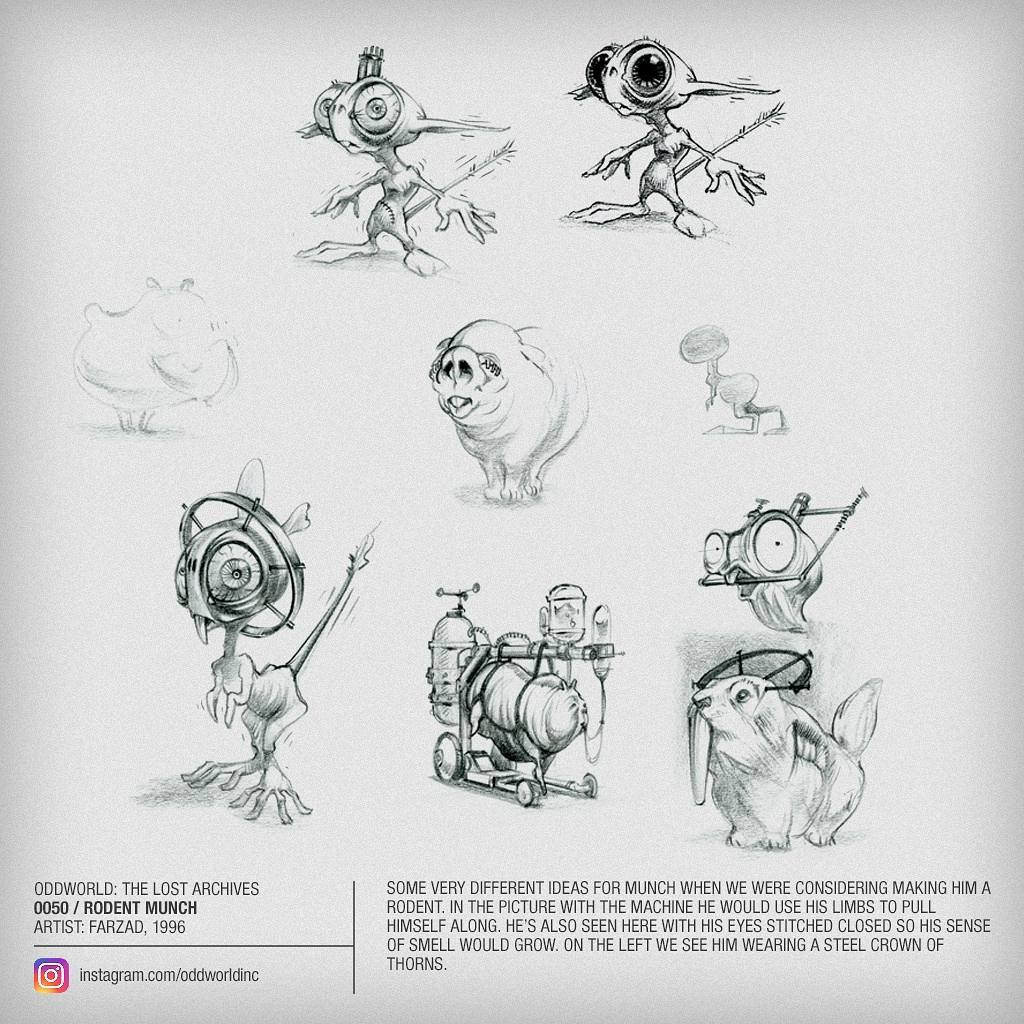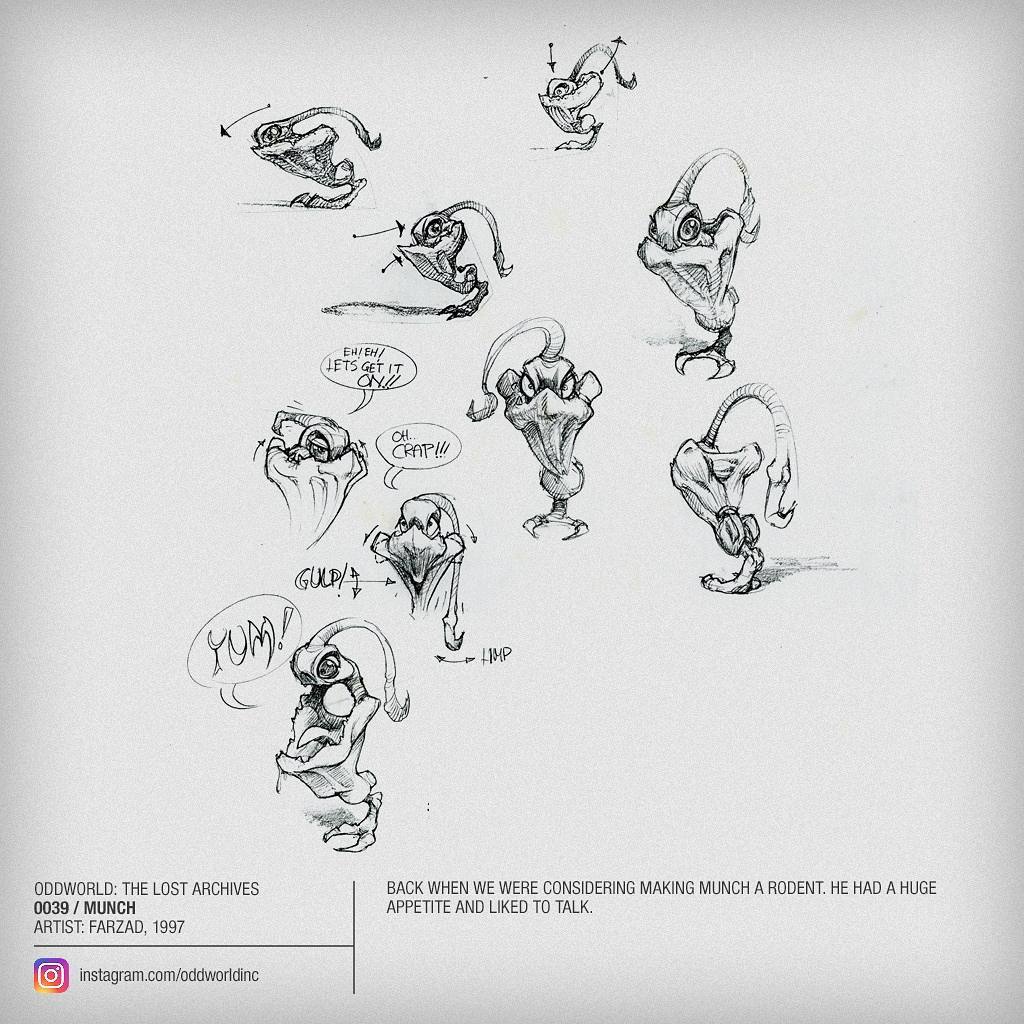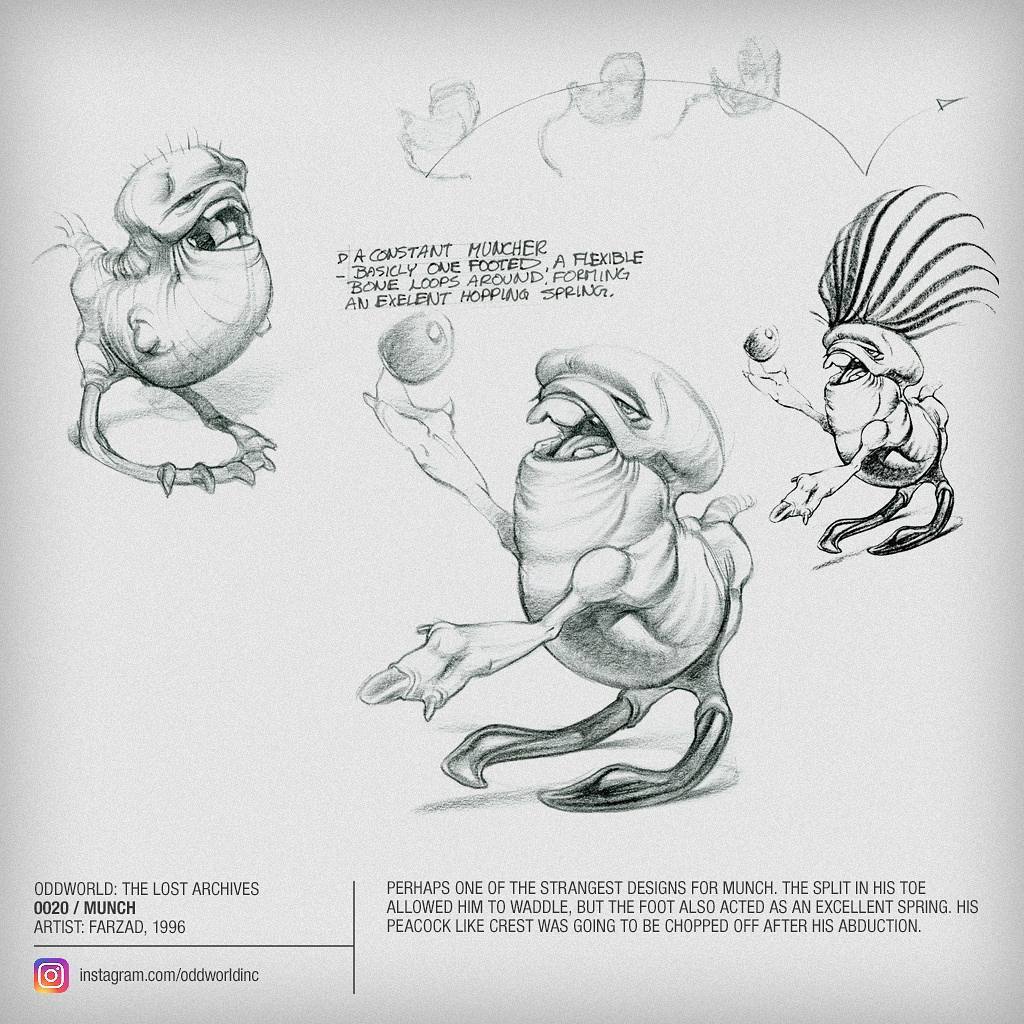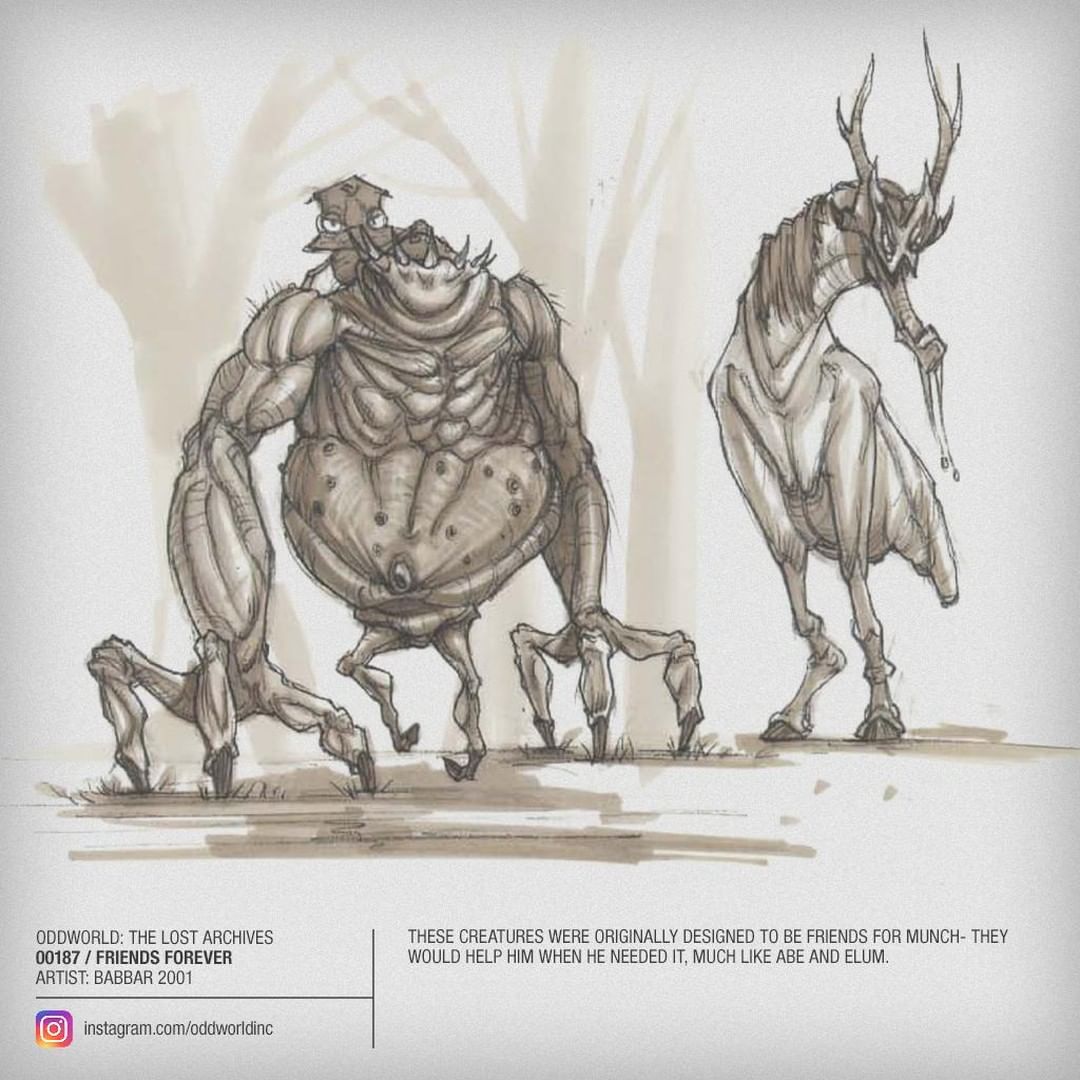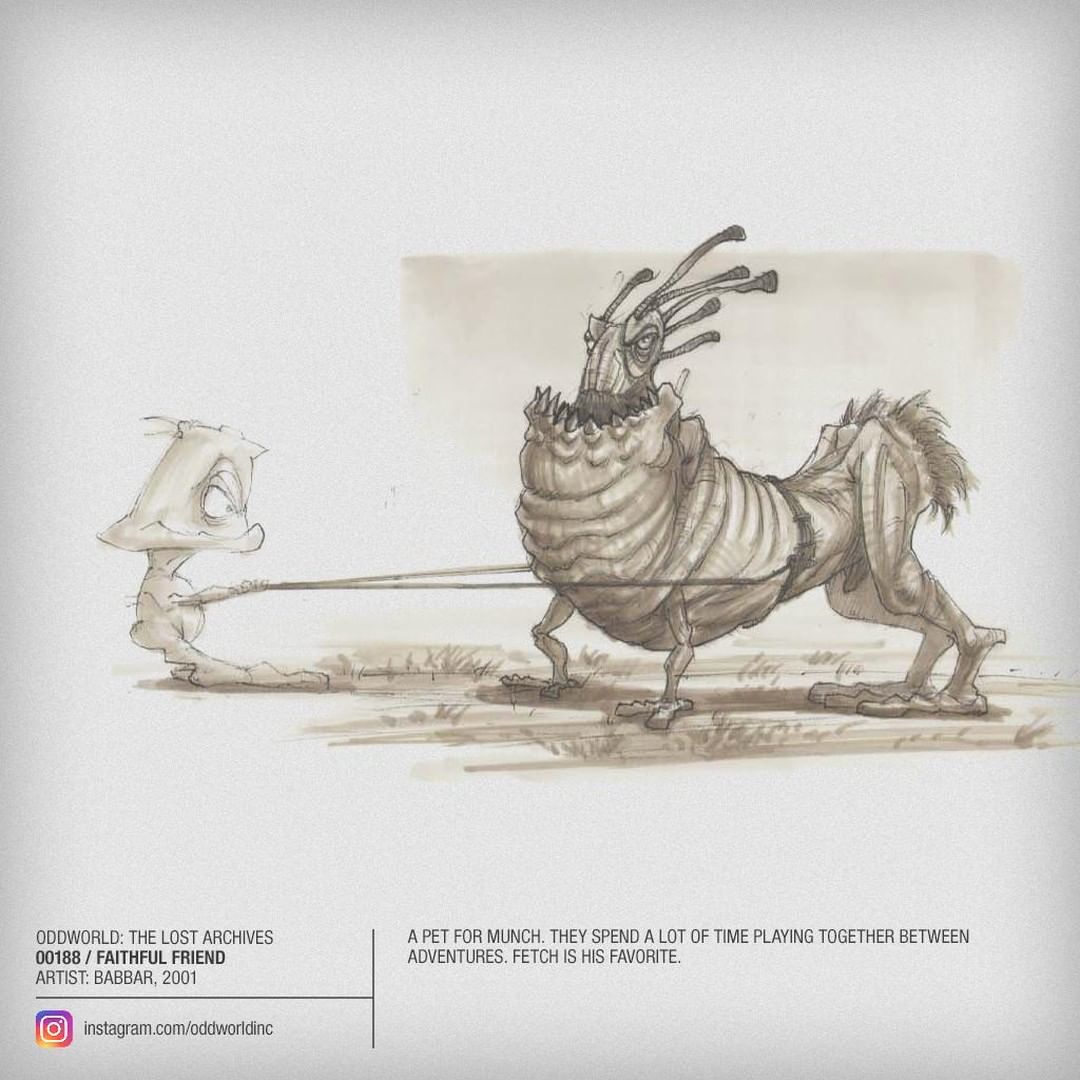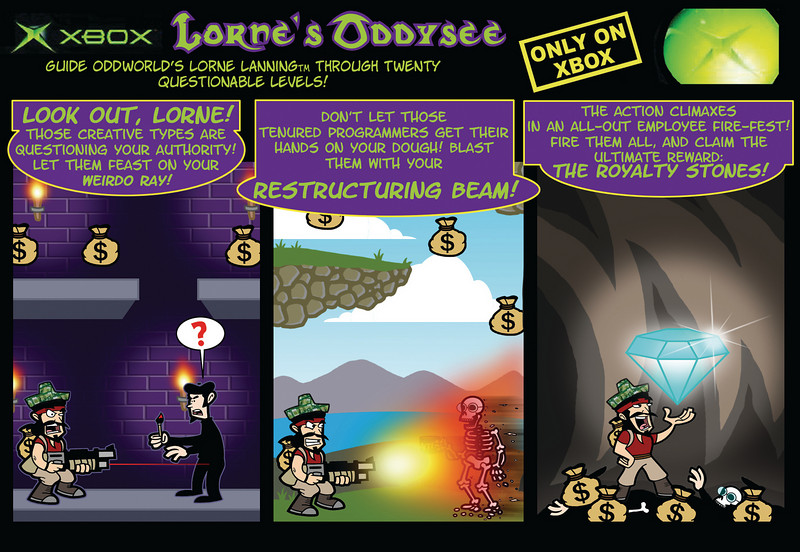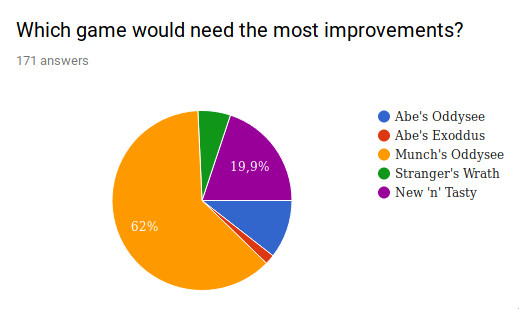Munch on the Operating Table
In this post I intend to try something I haven’t tried before, namely a long-form blog-post where I go over a topic in unnecessarily large depth. And what topic would be better to dissect this way than Oddworld’s perhaps most controversial installation, Munch’s Oddysee.
This whole post was inspired by two things, first a discussion on Reddit where people talk about their feelings about the series (I especially recommend /u/Capt_Baggins’ comment) and second by an argument I had with a friend of whether it is worthwhile to write long-form about something you don’t even like. I was skeptical, but I figured perhaps I’m just talking without experience, so this post is also an attempt to try myself out at something like this.
I have received some help while writing this text from a friend, who wishes to remain unnamed; in the form of a shorter (kind of unfinished) essay, parts of which served as inspiration. I implore you to read this too, as it gives a short overview of the issues and a different perspective. The essay can be found here.
So, settle in and prepare yourself, as this one is a doozy. Enjoy!
Contents:
- Introduction
- The Technicalities
- The Characters
- The Humor
- Issues around Development
- Aftermath
- Conclusion
Introduction
Or rather, how I was introduced to Munch (if you’re not interested in the backstory, feel free to jump to the next section), because surprisingly for the longest time I didn’t even know Oddworld wasn’t just the two Abe games. My first experiences with the games were at a very young age (similarly to a surprising number of people) and in sadly less than legal circumstances, as the disk we had was in fact a pirated copy. But before anyone gets their panties in a twist, I’ve since bought the games obviously and perhaps my contributions to the fandom have re-payed this horrible travesty. Why am I bringing this up, you ask? Well the reason is that because of the disk not being legit, the cover too was a shoddily cut out piece of paper taped onto the box; in fact it wasn’t even AO’s box-art, rather Munch’s! So for several years I kept wondering just who the hell that weird fish-guy could be as you don’t meet him anywhere in the game. However, this of course didn’t stop my enjoyment of the game, until I finally had enough and moved on.

I have sadly lost the disk since, but this is the exact image that was on it (which also serves as the cover of the game’s original Xbox release.)
Things took a turn years later, when for some reason I was browsing the Oddworld wiki, now armed with a rudimentary knowledge of English (as you might have guessed from my earlier posts or perhaps my videos, I’m not a native speaker), I suddenly noticed that there are two more games in the list than I knew about. It’s safe to say that I was terribly excited, I mean, I loved AO and AE, they were basically my favorite games at the time. I kept binging them and now there is two more? Awesome! — Or at least that’s what I thought at the time.
Now, I’ll be honest: even at the time (we’re speaking close to a decade at this point), I wasn’t terribly impressed by what I’ve seen. Munch looked ‘janky’ and didn’t seem to have the same atmosphere as the older games did. Because of this and my lack of lunch money that I could waste on things like this, I soon let go of my interest in both Munch and Stranger; until the time I rejoined the fandom, many years later. Even then, it took me a good two years of sticking around to finally give it a go… and oh dear lord it wasn’t pretty.
The Technicalities
I have since been informed several times that the game’s PC ports are a mess (though, it’s not like other versions of the game aren’t bug-ridden); but still this was the way I experienced the game, so this is how I can describe it. I don’t own any (working) consoles - and frankly wouldn’t want to give out money just to try a slightly better version of this game -, so the HD PC version of the game will have to make do; especially since most of the issues I’ll bring up simply stem from the design itself and not from the atrocious bugs the game is riddled with.
The Graphics
This one is interestingly the most difficult to properly rate for me in this section, because despite the game’s age and its not exactly smoothest development (more on that later), parts of the game simply look great. For instance, Abe’s model is one that took me by surprise, it looked great while keeping the character’s identity intact. Similarly the Sligs’ model too looks faithful and great.
But sadly the pretty models aren’t impressive enough to fix the glaring issue: the game simply looks washed out. What I mean by this is that unlike the original two games, which took some heavy artistic liberties with the palettes and thus were able to give different areas main colors (for instance, the majority of RuptureFarms is brown, Necrum Mines is blue, Slig Barracks is green and so on), in Munch everything looks quite samey. Outside areas are all lush green meadows, Industrialist facilities are all gray concrete jungles; there’s no immediate association to the area you’re in, unlike in the Abe games.
This makes the game way less interesting to look at and a lot less memorable. Am I now in Sloghut 1027 or Sloghut 2813? You might be able to tell if you have enough experience in the game, but try to make the same comparison between any two areas in Oddysee. The only that might fit the bill are the endgame Zulags, but even those are quite different if you keep an open eye for the backgrounds.
The saddest thing is that the extra dimension 3D provides could have been used to great effect. We’ve already seen how imposing Glukkon facilities can be (think RF from the outside of SoulStorm Brewery), just give us that but in an interactive form. And I’m well aware I’m asking for a lot, but why even go 3D if it only hurts the game’s looks.
The Sound Design
This one is also somewhat of a mixed bag, but the distinction is quite clear: the music is great, the sounds otherwise range from “eh, okay” to “simply terrible.” Compare for instance the ding that plays when you complete an objective to the sound Munch makes while moving around on land. The latter didn’t become an ironic meme for no reason and on PC the problem is further exacerbated by the fact that on some surfaces you become sort of stuck, which causes the sound effect to play 10-15 times in rapid succession, delivering an unexpected ear-bleed to anyone who went in without a clue (like yours truly).
It is also really off-putting how some of Abe’s and the rest of the Mudokons’ voice-lines are directly taken from the old games, which not only means that they sound quite different to the new lines, but are also way more compressed, making it sound like the character is voiced by two different people from two different studios. Which is, if you think about it, not an entirely wrong analogy.
The Atmosphere and Gameplay
Bit of an odd marriage of two different categories, I know, but I feel like I need to handle them in one place for things to properly make sense. I think the two are too intertwined to be discussed separately, so don’t be surprised if there are going to be sudden shifts between the topics.
With this disclaimer aside, the best way I can sum up the gameplay of Munch is that it is simply mediocre. There isn’t any huge offense the game commits. The controls are solid for the most part (if a bit affected by the aptly named “2000s jank”), the gameplay has both empowering and disempowering moments as is tradition in Oddworld games, hell, it even tries to innovate by introducing new powerups and the controllable machines for Munch, but despite all the attempts, it just simply doesn’t come together organically.
Machinery
Let’s start with the machinery, because those are the easiest to explain and require the least extra narration. Basically, they don’t really bring anything new to the table. Let’s be honest, what’s really the difference between Munch plugging into a machine versus Abe possessing someone? Sure you need to move the possession orb instead of Munch, but otherwise it’s largely presentation. Both let you take control of something that’s originally on the enemy’s side and lets you exploit it, before ditching it. (The fact that Munch’s identity is extremely thin will be discussed down the line in more depth.)
Not only that, but there is usually no threat presented once you’ve finally reached the control panel. Cranes are indestructible and Snoozers respawn indefinitely. Compare this to how it worked in the old game: Yes, there were sections where you could try again as many times as you wished, but it was also combined with sections that punished you harshly if you messed up.
“Your Slig died before you cleared up all rooms? Too bad, start over!”
Some might think this is too harsh and players should first and foremost have unadulterated fun and such punishments only mess up the pacing, but I disagree. While I concur that fun is perhaps the most important part of the equation, another similarly unavoidable part is the weight of actions, which is sorely missing from Munch. Why’d you care that your Snoozer is under heavy fire? You obviously don’t, if it dies, you just immediately jack into another and continue the action. Imagine if for example, upon letting Phleg die in Exoddus, simply another spawned and you could continue where you left off (this is technically already easy to emulate by QuikSaving, but I’m not opening that can of worms). It’d take all the tension out of an otherwise famously nerve-wracking and memorable part of the game.
Powerups
Moving on, the powerups are probably the most obvious example of the game’s tired design. In the originals everything had an at least superficially explained reason for existing (other than grenade machines I suppose, which are worth an argument on their own, but this is about Munch). In Munch, however, the vending machines simply don’t make sense. Not only because it gives fabulous powers to anyone who consumes them (and yet the Industrialists never use them), but also because even the Native areas are littered by them. Sure in those places the machines have a much more tribal look to them, but that just raises extra questions. Did the Mudokons copy them? Did the Industrialists put them there? Surely not, since the “untainted” parts of the Mudokon world feature them. You might be rolling your eyes extremely heavily at this point, saying
“Holy shit man, it’s a video game, stop seeing so much into it.”
And you know, to a certain extent you have a point. Obviously the reason why these are littered all around is to give the player tools to solve the levels, but that’s not the point of my argument. Rather that in the previous games, it was (almost) always well-established why things are put where they are, while here gameplay clashes with the narrative.
To give a more practical example, consider SoulStorm Brew in Exoddus: There it makes a lot of sense why Glukkon facilities are littered with them. This is how they keep the workforce docile. It is a vital part of the story, we see how the average Mudokons feel horrible after drinking it, but still crave more. And as an added piece of brilliance, the Brew became part of the gameplay that the player can use and abuse against their enemies. Meanwhile in Munch, they’re never even really mentioned, except perhaps once or twice by the Shaman.
I think the issue could have been avoided altogether, if the focus was on these, instead of all those products the Vykkers made (think BabyChow, Lungbusters, etc.), that serve as little more than jokes, while not even appearing inside the game at all. Humphrey and Irwin could have bantered a bit about, how they cause all these wacky side-effects, thus giving these items “legitimacy” in universe, an easy joke source of how they literally don’t care about all these fantastic powers they grant and a sort of unease for players, knowing that the stuff the characters chug by the gallons are created by a bunch of cruel bastards, who probably murdered a million cuddly animals to make these products happen.
Leading
Another major tonal shift was the idea, that instead of being a mostly stealth-focused game, Munch’s Oddysee is largely about leading small “strike teams” of Mudokons and Fuzzles into battle and actively engaging in fights. To reflect this, Abe doesn’t die from one hit anymore and in times of dire need, he can even do a meager slap, that may - in lucky cases - end the life of an already quite beaten down Slig.
This of course fits into the idea Lorne Lanning has about the progression of the series, characters go from sole perpetrators, to rebels, to the leaders of full-blown guerrilla forces. However, the change between the “capabilities” of Mudokons is so without any fanfare, that it just feels jarring. It’s as if suddenly they realized
“Hey, holy crap, we can use our fists and such.”
I’m of course don’t expect a long, heart-felt cinematic of how Mudokons finally decide to rise up or whatever, just a bit of recognition that the fields are slowly getting even. With the Fuzzles this is of course less of an issue, considering they’re a new species, so there aren’t any expectations towards them. Perhaps, this could have been turned into part of the narrative: Through half the game, the Mudokons are still heavily affected by fear and Brew addiction, so they’re incapable of fighting and thus the scene is all Munch’s, but in the latter half of the game it’s an all around fragfest between Mudokons and Fuzzles vs Sligs and Vykkers.
Similarly, the “upgraded” Mudokon versions are just weird. Instead of spears or staffs or anything similar, the close-combat Muds use comically over-sized clubs. The ranged ones are even weirder, as we’ve seen the sort of ranged weapons Mudokons use in Abe’s Oddysee in the form of the slingshot-wielding guardians of the Monsaic Lines. In comparison, Munch’s “Mudarchers” wield “definitely not” machineguns disguised as arm mounted crossbows. Just to be clear, I’m not saying that Mudokons should use slingshots and only slingshots, variety is great, however it’s a sort of discrepancy in power levels, that their so-called holy sanctum is defended by some lads with a bunch of pebbles, while they have the technology to rival Slig firepower.
Grinding
Even if we put all these plot contrivances aside, it is just kind of disheartening that the old games’ nuanced approach of figuring out your environment, then stealthily navigating through it, while strategically using your tools is basically all but gone. In Munch’s Oddysee the side that has more strength usually wins…and even that is not exactly true as the odds are heavily stacked in your favor as you can just respawn the Snoozer or Big Bro you were using or resurrect your fallen and headbutt the brick-wall until it eventually collapses.
Similarly death became little more than an annoyance. Not only isn’t it a game over anymore (as you can just resurrect Abe with Munch and vice-versa), but also you can just QuikSave whenever you wish. And once failure becomes meaningless, so does victory. It doesn’t take effort, just time.
The Characters
Similarly to the bleakness I’ve described in the previous sections, the characters themselves got quite a few problems too.
Munch
The eponymous protagonist of the game who hardly feels anything more than a sidekick. I mean honestly, who even is this guy? We know that he’s the last of his species, but does that tell us of anything? He basically just exists and lets the narrative drag him around. He’s either bossed around by the Raisin or the Fuzzles, having no real agency on his own…in his own game. This took its toll, as Munch by my findings is the least liked protagonist out of the trio of Abe, him and Stranger.
Even now as I’m writing this, I’m raking my mind, trying to dig out something relevant to mention, but I really don’t have much. Even fans of the game, who tout how much the love this game don’t really have much to say on Munch’s personality based on my experiences.
The weird thing though is that Munch isn’t a quickly thrown together character. Based on all the concept art we’ve seen over the years, he went over dozens of iterations, maybe hundreds. So the question arises: Just why the hell is this guy so bland?
To be entirely correct, we do know that parts of his storyline and character were axed altogether. For instance, the well-known story of how Munch would have had received an aggressive steroid therapy from the Vykkers, which caused him to sometimes turn into a Hulk-like being upon being irritated enough. Another idea was that Munch would be a tapeworm, whom Abe could swallow and carry around, then regurgitate whenever necessary.
While I’m well aware, that this rapid iterating is how OWI usually does things, the amount of it done still sort of implies to me, that perhaps they had no real idea of what to do with the character. Sadly the end result of this indecisiveness ended up as a hollow shell, that exists, is good for marketing, but otherwise has no personality at all.
Abe
Well…he exists. He doesn’t undergo any particularly huge changes in personality between Oddysee/Exoddus and this game. This perhaps might not seem like a huge deal, considering this is Munch’s game after all, but I think that’s not a good approach. Characters really shouldn’t “just exist,” yet Abe is doing just that. Just like in Oddysee and Exoddus, he’s still the same schmuck who gets bossed around, the only difference being that this time it is the Raisin who tells him to do stuff. If anything we should have seen the beginnings of Abe’s transformation of a survivor into a leader. It’d even fit the game well, considering Mudokons are now willing to fight for him.
However, all we get is a small fourth-wall break from him at the end of the game, when he says
Abe: “You know, most of the time, when I leave a mean place like that, it blows up.”
The joke isn’t lost on me, but I’d argue the chuckle it might induce in the audience is traded for a blow to the seriousness of the series. Don’t get me wrong, Oddworld was never a terribly serious series, but while it always provided ways to laugh with the game, the game never made fun of itself.
A Quick Aside
I have mentioned both in Munch’s and Abe’s case that they’re being bossed around by higher powers and fate too and some would probably consider this a deliberate narrative choice, showing how these well-intentioned but naive characters keep being used by others as pawns. I have no problem with this, I like it, it’s oddworldian, the problem rather is that the characters don’t mature at all. Abe in Abe’s Oddysee could be freely swapped to Abe in Munch’s Oddysee and basically nothing would change.
It’d make for an even more compelling narrative to see these characters realize that they’re being played by others and subtly subverting their control, until the whole thing turns into a war on three fronts. Or perhaps, to keep up the bleak atmosphere, Abe and the rest of protagonists could try again and again to break free, only to realize that they actually fulfilled some scheme all along.
I understand, that Oddworld is much more a story about the world itself and less about the individuals, but still, they don’t exist in a vacuum, the story should reflect that.
Lulu
Despite all, I consider Lulu the most likable character of the entire game and I’m genuinely unsure whether that’s a good thing. Ironically, despite being the least active member of the cast, he undergoes the most “character development” by undergoing a rags-to-riches then a riches-to-rags moment. Obviously he wouldn’t fare well as a main character, but as a half-joke/half-plot device, he works well.
The only thing I find lacking in him is a bit of extra characterization. We hardly get to know the guy, as he basically spends the whole game sleeping. How did he even get all those donation booths? And how did every Glukkon get one? Question I don’t think even Lanning knows the answer to.
The Almighty Raisin
I hate this character and I hate the fact that I have to hate him. Here’s someone who canonically existed for potentially thousands of years, so could lay some heavy story beats for us to broaden our perspective on the world…and what do we get? A senile old guy, who is nonetheless revered by the Mudokons.
Those who might have no idea, the Raisin has a backstory. He used to be this ancient tree, who upon sensing danger shed it’s original form to become a being that can communicate and forewarn a huge catastrophe. Of course the game won’t tell you this, you need to dig into promotional material and whatnot. Point is, the existence of this character is more or less a big middle finger to any fan who perhaps hoped to hear a bit more about the world.
Not only this, he’s basically a thinly veiled plot device, instead of events naturally reaching the protagonists (by defectors or catching a rebel broadcast or maybe reading the Daily Deception or any sort of way), he just straight up tells Abe and Munch
“Hey, go here and here for plot reasons.”
It just keeps a choke-hold on the world. Any of the aforementioned ways would have let us peer a bit into the cultures and groups, but no, we need a character that just readily gives away info, why even bother.
The Shaman
What the BigFace did elegantly and without a word (except in the bad ending I guess, but that hardly takes away from the point), this clown does with several forced jokes and hand-holding. Imagine if on every few screens in Abe’s Oddysee, the BigFace would pop up saying something like,
“Sup Abe, you need to use your acrobatic skills and traverse some obstacles. Don’t forget your possession ability either!”
It’d be horrible! And yet in a game like this that has huge areas that yawn with emptiness, a literal guide is necessary so the players don’t feel that lost. His presence also takes away from Abe’s character, who got around pretty well with minimal direct guidance before, now he’s apparently an idiot, who literally needs to be spoon fed how to get around.
His demeanor caused him to become sort of a meme in the more hard-line parts of the fanbase, especially his catchphrase that he utters whenever you make him shut up:
“No respect!”
Humphrey and Irwin
They’re a mixed bag. On one hand, unlike Exoddus’ three stooges, they are actually menacing villains, while also cracking some not-terrible jokes and they caused quite a few people to sleep unwell who experienced the bad ending. On the other hand, for nearly half of the story they simply screw off and don’t even appear for a second.
To be frank, Munch isn’t guilty alone with this issue. In Abe’s Oddysee, Molluck too sort of forgot to appear for three quarters of the game, but similarly to this horror-duo his presentation was strong enough to carry it through the game. However, while this is justifiable in Molluck’s case as he was the villain of the very first game, I think Munch’s Oddysee could have went one step further, if only to further exemplify just what Abe and Munch are fighting against.
The Rest of the Characters
Munch’s Oddysee started the annoying trend of chatty characters, who simply have to make their presence known every five seconds or so. On one hand the system is a semi-elegant way of letting the player use one of their senses naturally to locate elements of gameplay (instead of something immersion-breaking like an outline to characters that you can see through walls or similar.) On the other, however, there simply aren’t enough lines for the characters to keep the concept fresh and quickly you’ll start recognizing the half-dozen legible and few completely gibberish lines the characters idly mutter to themselves and to each other.
The fact that every single character are carbon copies of each other can be noted as a problem, as the Xbox’s stronger hardware surely would have allowed a few different models, but honestly, this is least concerning, the previous games had only one variation of each character, so it’s not that big of a deal.
I think the voice problem would have been way less noticeable if either characters spoke much more rarely, they had way more voice lines or perhaps if they had special voice lines that played whenever something happened on the level, which would also increase immersion.
As for the Fuzzles and Interns, who both only speak gibberish, I guess the problem doesn’t really apply. I liked the design of the latter, since being a bunch of goalless workers, who are so uninterested in life that working with their mouths sewn shut is okay for them is a pretty gruesome concept. Fuzzles on the other hand are still perhaps one of the most boring creature designs in Oddworld, second only to the Stranger’s Wrath’s overgrown chickens, the Clakkerz.
The Humor
Slig: “Ayy, buttwipe!”
Now, I feel like I have to preface this: humor is extremely subjective, so while the whole writing is largely an opinion piece, this part is even more so. Still, it is an important part of my review, so I can’t leave it out. I will write in a tone that presents my opinion as if they were facts, because it’s both easier to write and more pleasant to read, but I obviously recognize that they aren’t. So yeah, in this section just imagine the words “in my opinion” into any and every sentence you read.
Munch’s Oddysee is simply too crass to be funny to me.
I adore the older games’ humor. Abe stumbling around, being a complete klutz, the overreactions of the Glukkons, the Newscaster Slig, it’s all good fun. While it isn’t particularly nuanced, it is miles better than the absolute toilet-humor Munch presents. Most of the jokes that the characters make are on the level of calling others crap or similar, like the only wants to appeal to an audience made up of 12-13 years olds. This is also painful in another way, as it completely takes off the edge of some characters who used to be absolutely menacing. Think about Sligs for instance, while in Exoddus they served as comic relief in cutscenes, in-game there was no joking around, they still beat the slaves and shot you without wisecracking.
For another, more hands on example, let’s take possessing Glukkons in Exoddus and Munch: In the former, it is both an empowering moment of finally bossing others around, with the whole establishment suddenly becoming your ally and also an implicit source of jokes as while the Glukkons walk you can faintly hear the sound of a xylophone and whenever they accidentally hit a wall, they just flop and then stand up with a deliciously contemptuous grunt. Also whenever you possess a head Glukkon, they have a bunch of amusing lines that became memes in the fandom, whether it’s “that blue bastard” or “Dripik! I knew that!” these lines gave these otherwise rarely appearing characters lovable personalities. In Munch, however, they basically became “timewasters,” all of them are locked inside tiny rooms, where the only thing you can do with them is to dish out some cash for Lulu. It’s nothing different than pushing a button. The lines they utter after losing their fortune are also very generic and have way less of an impact, because why’d you even care about these characters?
Even in presentation the game is lying way too heavily on trying to be funny, which ultimately caused it to fall on its face for me. The comically sped up animations, Abe curling into a ball every time he jumps, herding one eyed sheep… The whole thing just feels like OWI wants to say something like this,
“Hey kid, remember the originals? They were dark and moody, right? Well dont’cha worry, this one is full of fun and youthful energy!”
And no, the disturbing ending doesn’t provide enough counterweight, when the game is otherwise so full of silliness.
Issues around Development
Not only did the game have a very ambitious scope, it was also struck by several unlucky (and in some cases perhaps malicious) events surrounding its development. Here you can read some of these:
The PS2-Xbox Switcheroo
If you are old enough, you might remember this, hell, perhaps you’re one of the unfortunates, who fell victim to this. Through most of its marketing cycle Munch’s Oddysee was heavily pushed as a PS2 launch title and several pieces of media wrote about it as such. I’ve spoken with multiple people, who in anticipation of the game bought a PS2 from their saved up cash…only to be severely disappointed, when OWI sneakily struck a deal with Microsoft and turned Munch into an Xbox title.
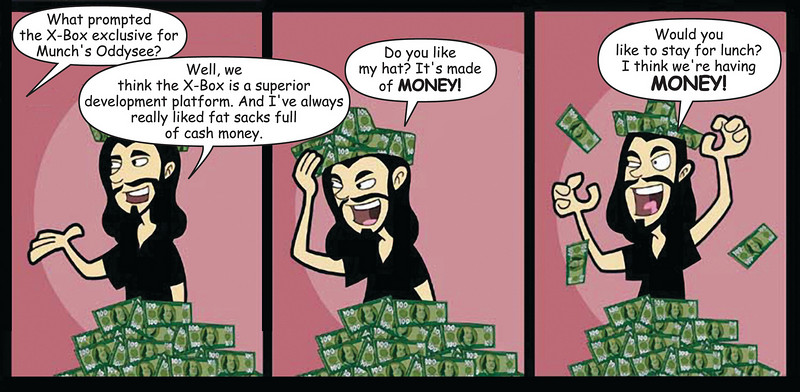
Penny Arcade is well known for their comics that satirized OWI’s overly financial-oriented choices.
Now, financial-wise this was an excellent move for OWI. They got basically limitless funding from the tech giant and also the chance to develop for the stronger platform of the Xbox. However, it both caused much harm to the fans, who felt like they were cheated (especially the ones mentioned above) and caused development to become somewhat disoriented.
Whether OWI had to start from scratch because of the platform-change is an interesting question. While many people claim that they had to start again from zero, it is actually entirely possible that they were able to port a part of their already existing work, as it turns out Munch’s Oddysee ran on the Gamebryo engine (also known as NetImmerse, the same engine that powered Morrowind, Fallout 3 and a bunch of other games), which was in fact made with cross-platform deployments in mind, meaning it could be used to create games for both the PS2 and the Xbox.
The very late switch-up also caused OWI to need to take some really desperate measures, including firing most of the development team in exchange for a few new developers, who rewrote a large part of the game, just months before the release date.
Amusingly the same platform-change was later pulled off with Stranger’s Wrath again, but that’s a story for another time:
PlayStation 2 Magazine: “Like an ex-girlfriend who offers a mercy shag and then changes her mind at the last minute, Oddworld Inhabitants has decided not to bring its new game to PS2 after all. Oddworld Stranger, published by EA, was due to mark the developer’s return to Sony hardware, but apparently the PS2 version was too far behind the Xbox to make a simultaneous release viable. It’s a shame really, but we’re not about to lose any beauty sleep over an alien cowboy.”
One thing is for certain, while Microsoft has a lot of blood on their hands, the failure of Munch wasn’t their fault. If anything, they provided the means for the game to become reality in the first place, thus blaming them is misplaced anger.
“False Advertising”
I’m putting the title in quotes as technically there is no way to prove that this was in fact the goal, however, based on what Lorne Lanning said, it’s hard not to consider them as such. I’m of course talking about the so-called “visualizations.” What are these? I’ll refer you to a quote from an article:
Game of X: Lanning performed what he called “a jujitsu.” From his days working in the aerospace industry, he remembered that they often created “visualizations” of future products. So what Lanning did is have his crew pre-render game scenes from Munch. Because these scenes were not rendered in the PS2 devkit, but were simply “visualizations” of their product, it was perfectly legal for them to share them, which they did. They made about a hundred CDs with these game visualizations and sent them to major media contacts. They said, ‘Hey, look at what we’re working on. Here’s the movie clips. Here’s screenshots. Here’s the story about Munch’s Oddysee.”
As written above, these were animated scenes that were all but presented as actual gameplay footage. There are still many of these floating around on Youtube, some calling them “betas,” some cut content, but in fact they were nothing more than OWI saying “this is what we wish Munch to be.”
This of course didn’t help in tempering expectations and only serve as a testament of all the promises this game left unfulfilled.
Cut Content
Perhaps the most hurtful part of the entire ordeal. If you spend some time reading what sort of stuff Lorne Lanning said about the game before its release, you’d probably get quite a different idea than what ultimately became of Munch.
Below you can read some examples. They’re pretty nice as ideas, but let’s be honest, half of this stuff couldn’t even be accomplished even with today’s tech without major compromises or simplifications.
Wealth / Status
In this hypothetical version of Munch, all characters stand somewhere on the social ladder. If you possess a nobody, then you probably won’t achieve much as the poor guy won’t be taken seriously. To circumvent this you could either possess someone with more wealth and status or take out a hefty loan, thus give the impression that your character is way richer than they really are. This gives you access to new areas and lets you boss around people under you.
While money in a really minimal way does appear in the game (think of the Lulu donation machines and how it drains Glukkons), this status system was completely axed.
Terraformation
Depending on the choices you took in the game (which will be discussed in the next section), the terrain would dynamically change to reflect how environmentally responsible you were. This means that eventually the levels would either become desolate landscapes or lush, thriving grooves.
This too was completely axed as a consequence of the following feature being cut.
Multiple solutions
While it is true, that you have some options (like whether you want to save the Mudokons and Fuzzles or not), the way this was originally described is that each level would have had several solutions, some helping the world, some ailing it. Players would have had the agency to decide whether they want to take the easy but destructive path or the more challenging route that needs some out-of-the-box thinking, but in return steer themselves towards the better ending.
Munch the Beastmaster
Another scrapped content was the idea that Munch would have been able to tame different sorts of wildlife, who could help him solve his troubles.
PlayStation Magazine UK: “Just as Abe possesses living creatures, Munch possesses mechanical devices to rescue animals from traps, setting them free, then leading them to places where he can nurture them into bigger and better things that he can then use to his advantage.”
While this is obviously cut, some vestigial remains of this concept still exists in the game in the form of Munch being the only creature who can understand the Fuzzles as their speech is gibberish to Abe.
“Smarter” GameSpeak
PlayStation Magazine UK: “Obviously communicating with these creatures will require a vocabulary slightly more sophisticated than the phrases and farts of the Abe games. How this will be achieved on what is essentially the same joypad is anybody’s guess, but Lorne claims that, ‘Gamespeak will become much more highly evolved and smarter, but also much simpler to understand and use.’”
I don’t think this requires much explanation, unless he literally meant that instead of one line for each GameSpeak, there is now three or four; MO’s GameSpeak is basically the same as in the older games, albeit with even less things to say.
Aftermath
G-Man, Half Life 2: “So, wake up Mr. Freeman… Wake up and smell the ashes.”
While Munch sold relatively well and found its audience in the fandom, some even considering the game their favorite, the professional reception of the game was a much more mixed bag compared to the universal acclaim the originals received. It also caused Microsoft to go back on the three game publishing deal they struck with OWI, leaving them to look for a new partner, whom they ultimately found in EA… And we know how that ended.
Contemporary blog-post about Oddworld: “Then, before the Xbox launch, Lanning goes on the PR circuit to declare that the Xbox will be the exclusive home of his Oddworld games because only the Xbox is powerful enough to handle his vision. His vision being an item-collecting mascot platformer. Oh yeah, no other system could possibly handle something as complex as that. The game, Oddworld - Munch’s Oddysee, is touted as one of the major players in the Xbox’s original lineup, but no one buys it. Oddworld is effectively DOA.”
One memorable review describes Munch as a “great game, but it’s a little long”:
One can say without much hesitation that Munch’s overly ambitious goals and yet less than stellar delivery practically set up OWI for its closure after Stranger’s Wrath’s release, as the company got a nasty mark on its prestige which barred them from partnering with more supportive companies. This is why saying that EA killed Oddworld is short-sighted I think. Their lack of marketing might have delivered the final blow, but OWI by then was already pretty heavily bleeding from a self-inflicted gunshot in the foot.
Conclusion
Well, we’re almost 6000 words in; so if you’ve reached this far, congratulations! While it might seem that I’m very harsh on this game, that really isn’t the intention. I’m just trying to hold it to the same standards as the old ones. To summarize the problem with Munch, it simply wasn’t different enough to be interesting, nor samey enough to capitalize on nostalgia and the tried-and-true methods of Oddysee and Exoddus.
Munch today lives on as a niche-inside-a-niche, considering Oddworld isn’t as much of a household name as it used to be. My queries into the fandom decisively put it the second least liked Oddworld game just after New ‘n’ Tasty.
OWI too made it quite clear that Munch is more or less a sunken ship. While they don’t mind re-releasing it every once in a while on new platforms (it’s free money, yo), Soulstorm effectively retcons Munch’s Oddysee leaving the character in the abyss between the canon and the obsolete lore. Apparently Lanning still considers Munch a character that’s part of the universe, but every other circumstance is up in the air…and frankly maybe that’s for the better.
Thanks for sticking by.


